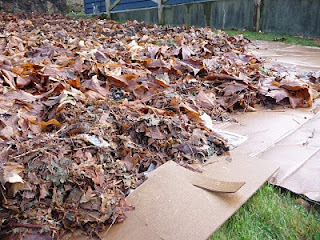Lasagna Gardens--Layers of Goodness -
The leaves are really falling at my home here in SW Ohio. And with this great source of organic material, I set out to put it to use in a lasagna garden
So I've put on my thinking cap, and decided to ease my chores which are seemingly endless.
Usually, I mulch the leaves  back into the yard, adding much needed organic nutrients. I've also bagged a few loads of grass and leaves to add to the compost pile. Over winter this will turn into black gold for my spring garden.
back into the yard, adding much needed organic nutrients. I've also bagged a few loads of grass and leaves to add to the compost pile. Over winter this will turn into black gold for my spring garden.
Planning ahead for your spring garden is sooo easy. Find a spot along a fence, or an area out in the sunshine for a vegetable or cutting garden. Raid a local dumpster for cardboard, or gather old newspapers at least 7 - 10 sheets thick and lay out your garden.
Here is where the 'lasagna' comes into play. Layers, and layers. Add the leaves, and grass clippings on top of watered down cardboard. Overlap the paper layer to block out any weeds. That's right! No removal of sod, weeds or even rocks is necessary. Add peat moss several inches deep, and add layers of compost too.
Anything you would put into your compost pile is fair game. Pruned branches, kitchen scraps, (no bones or meat), aged manures, coffee grounds, shredded junk mail, wood chips, or bonfire ash.
pile is fair game. Pruned branches, kitchen scraps, (no bones or meat), aged manures, coffee grounds, shredded junk mail, wood chips, or bonfire ash.
The bedding material from the kids rabbits is also great. Add bone meal and wood ash for a good source of Phosphorous and Potassium - the P-K, of the N-P-K needed by your plants.
Just think how nature gardens - the forest floor is a layer upon layer, season after season of debris which turns into the dark, rich loam we covet in our own gardens.
This lasagna bed has a border of straw bales so this gardening is approximately 14" deep. As the organic material degrades, the microorganisms get to work to provide nutrient rich planting material. This also makes the need for fertilizers less next season. Avoid using treated lumber as a border. The chemicals can affect your food crops.
The no-till garden bed that is loose, crumbly, and fluffy is a great advantage. Over wintering your lasagna garden is an ideal way to plan for spring. We have all the ingredient for a very productive crop next year.
The moisture of the fall rains, and the freezing and thawing of the winter weather aid in the breakdown of the organic materials.
The lasagna garden
AAHHH....
Envision your space. Enrich your space. Enjoy your space.
Thanks for visiting today. What will you do with your spare time?












No comments:
Post a Comment